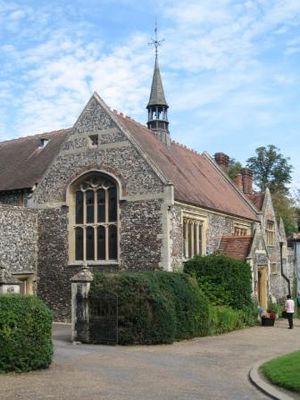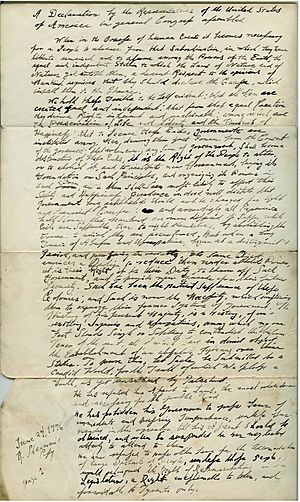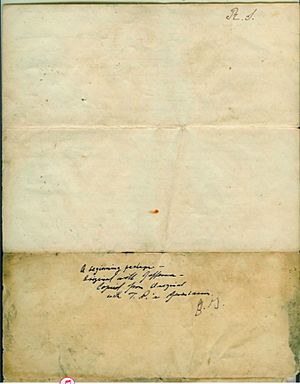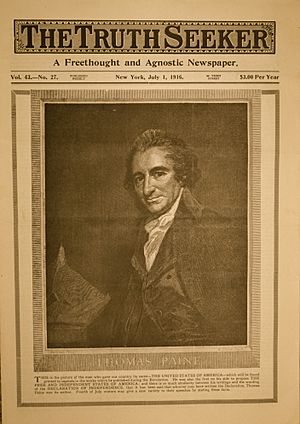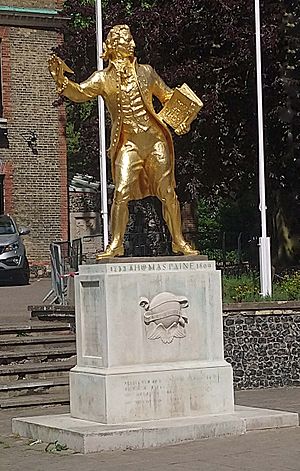Thomas Paine facts for kids
Quick facts for kids
Thomas Paine
|
|
|---|---|
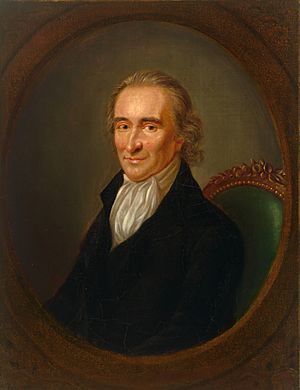
Portrait by Laurent Dabos, c. 1792
|
|
| Born |
Thomas Pain
February 9, 1737 (N.S.) |
| Died | June 8, 1809 (aged 72) |
| Spouse(s) |
|
| Era | Age of Enlightenment |
| School | |
|
Main interests
|
|
| Signature | |
Thomas Paine (born Thomas Pain; February 9, 1737 – June 8, 1809) was an English-born American writer and thinker. He was a philosopher and a revolutionary who believed in big changes.
Paine wrote two very important pamphlets: Common Sense (1776) and The American Crisis (1776–1783). These writings helped inspire the Patriots to declare independence from Great Britain in 1776. His ideas were based on the Enlightenment, which focused on human rights for everyone, everywhere.
Contents
Early Life and Education
Thomas Paine was born on January 29, 1736 (or February 9, 1737, in the new calendar). His parents were Joseph Pain, a farmer and stay-maker, and Frances Pain. They lived in Thetford, Norfolk, England. His father was a Quaker, and his mother was an Anglican. Thomas started using the spelling "Paine" for his last name around 1769.
He went to Thetford Grammar School from 1744 to 1749. Back then, going to school was not required for everyone. When he was 13, he started working for his father as an apprentice. At 19, Paine briefly worked on a privateer ship, which was a private ship allowed to attack enemy ships.
In 1759, he returned to Britain and became a master staymaker, making stiff parts for clothes. He opened his own shop in Sandwich, Kent.
On September 27, 1759, Paine married Mary Lambert. Sadly, his business failed soon after. Mary became pregnant, and they moved to Margate. She went into labor early, and both she and their baby died.
In 1761, Paine returned to Thetford to work as a tax officer. He became an Excise Officer in Grantham in 1762. In 1764, he moved to Alford. In 1765, he was fired for saying he had checked goods he hadn't. He asked to be hired back, and they agreed in 1766. While waiting, he worked as a staymaker again.

In 1767, he got a job in Grampound, Cornwall. He later became a schoolteacher in London. In 1768, he was sent to Lewes in Sussex. This town was known for not liking the monarchy. He lived above a tobacco shop there.
Personal Life
On March 26, 1771, when he was 34, Paine married Elizabeth Ollive. She was the daughter of his landlord, who had recently passed away. Paine then took over his father-in-law's grocery and tobacco business. He and Elizabeth officially separated on June 4, 1774. After their separation, he moved to London.
American Revolution
In September 1774, a scientist named George Lewis Scott introduced Paine to Benjamin Franklin. Franklin was in England to speak for the American colonies against British rule. Franklin was also the editor of a big American newspaper, The Pennsylvania Gazette. Franklin suggested that Paine move to Philadelphia. He gave Paine a letter of recommendation. Paine sailed to the American colonies in October and arrived in Philadelphia on November 30, 1774.
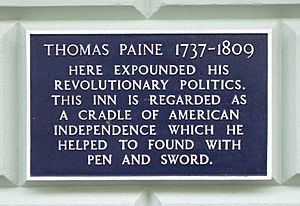
Paine barely survived the trip across the ocean. The ship's water was bad, and many passengers got sick. When he arrived in Philadelphia, he was too sick to leave the ship. Benjamin Franklin's doctor helped him, and it took Paine six weeks to get better. He became a citizen of Pennsylvania very quickly. In March 1775, he became the editor of the Pennsylvania Magazine.
Paine arrived just in time to be part of the American Revolution. Almost every rebel read or heard his 47-page pamphlet called Common Sense. It was a huge bestseller and helped convince people to demand independence from Great Britain. The American Crisis was another series of pamphlets that supported the revolution.
Possible Role in the Declaration of Independence
There is no clear historical record that Thomas Paine helped write the Declaration of Independence. However, some historians have wondered if he was involved.
In 2018, the Thomas Paine National Historical Association found an early draft of the Declaration. It had "T.P." written on the back. This draft is called the Sherman Copy. John Adams made this copy on June 24, 1776, for Roger Sherman to review. The inscription on the back says: "A beginning perhaps-Original with Jefferson-Copied from Original with T.P.'s permission." The association believes "T.P." refers to Thomas Paine.
It's not clear exactly how much Paine helped with the Declaration's words. The original draft mentioned in the inscription is now lost. But John Adams asking for "T.P.'s" permission might mean Paine helped Thomas Jefferson organize ideas or even wrote some of the text.
French Revolution
Paine lived in France for most of the 1790s and became very involved in the French Revolution. While he was in England, he wrote Rights of Man (1791). This book defended the French Revolution against people who criticized it. Because of his strong words against a British writer named Edmund Burke, Paine was put on trial in England in 1792. He was found guilty of "seditious libel," which means writing things that encourage people to rebel against the government. He was not there for the trial.
The British government was worried the French Revolution might spread to Britain. So, they started stopping books that had radical ideas. Paine's book, which said people had the right to change their government, was a target. An order for his arrest was issued in 1792. Paine quickly left for France in September 1792.
Paine strongly supported the French Revolution. He was given honorary French citizenship, just like other important people such as Alexander Hamilton and George Washington. He received this honor because of his book Rights of Man, Part II, which was very popular in France. Even though he couldn't speak French, he was elected to the National Convention, which was France's government.
In December 1793, Paine was arrested and sent to Luxembourg Prison in Paris. While in prison, he kept working on his book The Age of Reason (1793–1794). James Monroe, who later became a U.S. President, used his diplomatic connections to help Paine get released in November 1794.
Paine became well-known for his writings and for criticizing people he felt had betrayed him. In The Age of Reason, he supported Deism, which is a belief in God based on reason, not on religious texts or traditions. He promoted reason and freethought. He also argued against organized religions. In 1796, he wrote a harsh letter to George Washington. Paine felt that Washington, who had been his friend, had not helped him when he was in prison in France. Paine believed Washington had betrayed him.
In 1797, he published a pamphlet called Agrarian Justice. In it, he talked about how property began and suggested a way to give everyone a basic income. This would be paid for by a one-time tax on landowners.
Later Years
Around 1802 or 1803, Paine left France and returned to the United States. He also paid for his French friend Nicolaus Bonneville's family to come to the U.S. This included Bonneville's wife, Marguerite Brazier, and their three sons, Benjamin, Louis, and Thomas. Paine was the godfather to Thomas Bonneville.
Paine was not welcomed by many of his old friends and supporters. This was because of his strong views on religion and his criticisms of George Washington. He was even denied the right to vote in New Rochelle.
Marguerite Brazier took care of Paine at the end of his life and buried him. In his will, Paine left most of his property to Marguerite. This included 100 acres of his farm. This was so she could take care of and educate Benjamin and Thomas.
Death
Thomas Paine died on June 8, 1809, at the age of 72. He passed away at his home in Greenwich Village, New York City. The original building is gone, but a plaque marks the spot where he died.
After his death, Paine's body was taken to New Rochelle. However, the Quakers would not let him be buried in their graveyard, as he had wished. So, his remains were buried under a walnut tree on his farm. Only six people came to his funeral. He had been avoided by many because he had criticized Christianity and some national leaders.
In 1819, an English journalist named William Cobbett dug up Paine's bones. He took them back to England, planning to give Paine a hero's reburial. But this never happened. The bones were still with Cobbett when he died more than 15 years later. After that, they were lost. No one knows for sure what happened to them, though some people have claimed to have parts of Paine's remains, like his skull.
Ideas
Slavery
Paine was a strong opponent of slavery. He called himself an abolitionist, meaning he wanted to end slavery. As a secretary for the Pennsylvania government, he helped write laws to stop the slave trade.
Paine and another person, Joel Barlow, tried to convince President Thomas Jefferson not to allow slavery in the Louisiana Purchase lands. They suggested settling the area with free Black families and German immigrants instead.
State-Funded Social Programs
In his book Rights of Man, Part Second, Paine suggested a big plan for the government to help people. He believed this would make society better. His ideas included:
- Government help for poor people.
- Government-funded public education for everyone.
- Government support for prenatal care (before birth) and postnatal care (after birth), including money for families when a child was born.
- Paine also thought people should not have to work when they are old. He called for a government pension (regular payment) for all workers starting at age 50, which would double at age 60.
Agrarian Justice
His last pamphlet, Agrarian Justice, was published in 1795. In it, he argued against unfair land ownership. He said that land ownership kept most people from their natural right to survive independently. The U.S. Social Security Administration sees Agrarian Justice as the first American idea for an old-age pension and a basic income for everyone.
Paine wrote:
In helping those who have lost their natural inheritance, it is a right, not charity ... [Government must] create a national fund, from which every person, when they turn twenty-one, will receive fifteen pounds sterling. This is partly to make up for losing their natural inheritance because of the system of land ownership. Also, every person now living who is fifty years old, and everyone who reaches that age, should receive ten pounds per year for life.
In 2011, £10 and £15 would be worth about £800 and £1,200 (about $1,200 and $2,000) today, if we adjust for inflation.
Historians say Paine's ideas about property rights were very important. He believed in individual ownership but also in fairness for everyone. This made his ideas different from earlier thinkers. His ideas showed his belief in freedom for individuals and equal rights for all.
Religious Views
Before he was arrested in France, Paine wrote the first part of The Age of Reason (1793–1794). He knew he might be arrested and executed. Paine's religious ideas in The Age of Reason caused a lot of discussion. They divided religious groups into two main sides: those who wanted to separate church and government, and Christians who wanted Christianity to keep its strong social influence.
About his own beliefs, Paine wrote in The Age of Reason:
I believe in one God, and nothing more; and I hope to be happy after this life.
I do not believe in the beliefs of the Jewish church, the Roman church, the Greek church, the Turkish church, the Protestant church, or any church I know. My own mind is my own church. All national church organizations, whether Jewish, Christian, or Turkish, seem to me to be human inventions. They were made to scare and control people, and to gain power and money.
When we read the terrible stories, the wild parties, the cruel punishments, the never-ending revenge that fills more than half the Bible, it would make more sense to call it the word of a demon than the word of God. It is a history of evil that has made people corrupt and cruel; and, for my part, I truly hate it, just as I hate everything that is cruel.
There is no proof Paine was a Freemason. But after he returned to America, he wrote "An Essay on the Origin of Free-Masonry" (1803–1805). He thought Freemasonry came from the ancient Druids' religion. Marguerite de Bonneville published this essay in 1810 after Paine died. She left out some parts that criticized Christianity. Most of these parts were put back in a printing in 1818. In the essay, Paine said that "the Christian religion is a copy of sun worship. They put a man they call Christ in the place of the Sun, and worship him the same way the Sun was originally worshipped." Paine also had some negative views about Judaism. While he never called himself a Deist, he openly supported Deism in his writings. He called Deism "the only true religion":
The ideas I have shared ... come from a very clear and long-held belief that the Bible and the New Testament are tricks played on the world. That the story of man's fall, Jesus Christ being the Son of God, and his dying to calm God's anger, and salvation through that strange way, are all made-up stories. These stories do not honor the wisdom and power of God. The only true religion is Deism. By this, I meant and still mean, believing in one God, and trying to act like God's good character, or practicing what are called moral virtues. And it was only on this (as far as religion goes) that I based all my hopes for happiness after this life. So I say now—and so help me God.
Legacy
Historian Jack P. Greene said that "we are all Paine's children today." He meant that Paine and his new ideas about government, which became popular in Europe, changed the world. It wasn't just the British losing at Yorktown.
Harvey J. Kaye wrote that Paine's pamphlets and famous sayings like "The sun never shined on a cause of greater worth" and "These are the times that try men's souls" did more than just make Americans want independence.
[H]e also gave the new nation a democratic spirit and a special, world-changing purpose and promise. For 230 years, Americans have found ideas, inspiration, and encouragement from Paine and his work.
John Stevenson says that in the early 1790s, many groups that wanted political change formed in England and Wales. Paine's writings helped people who were new to politics feel more confident. Gary Kates argues that Paine's ideas brought together people from different places, like merchants, workers, and thinkers, into one big movement.
His writings have long inspired thinkers and working-class people in Britain and the United States. Many different groups, like liberals, libertarians, feminists, and free thinkers, see him as an important person in their history. Paine's criticisms of organized religion and his support for thinking with reason influenced many British free thinkers in the 1800s and 1900s.
The saying "Lead, follow, or get out of the way" is often thought to be from Paine, but it is not found in his writings.
Abraham Lincoln
In 1835, when he was 26, Abraham Lincoln wrote a defense of Paine's ideas about deism. A political friend, Samuel Hill, burned the paper to protect Lincoln's future in politics. Historian Roy Basler, who edited Lincoln's papers, said Paine greatly influenced Lincoln's writing style.
No other writer from the 1700s, except Jefferson, is more like Lincoln's later thoughts. In style, Paine, more than anyone else, shows the different kinds of powerful writing that, when softened and changed to fit Lincoln's own mood, can be seen in Lincoln's formal writings.
Thomas Edison
The famous inventor Thomas Edison said:
I have always thought Paine was one of the greatest Americans. We have never had a smarter mind in this country.... I was lucky to find Thomas Paine's books when I was a boy... it was truly amazing to read that great thinker's ideas on politics and religion. Paine taught me many things I had never thought about before. I remember very clearly the sudden understanding that came from Paine's writings. I recall thinking, at that time, 'What a shame these books are not schoolbooks for all children today!' My interest in Paine was not satisfied by reading his works once. I went back to them again and again, just as I have done since I was a boy.
South America
In 1811, a translator from Venezuela, Manuel Garcia de Sena, published a book in Philadelphia. It mostly contained Spanish translations of Paine's most important works. The book also had translations of the Declaration of Independence and the U.S. Constitution.
This book became very popular in South America. Through it, Uruguayan national hero José Gervasio Artigas learned about and adopted Paine's ideas. Many of Artigas's writings came directly from Paine's, including the Instructions of 1813. Uruguayans consider this one of their country's most important documents. It was one of the first writings to clearly state a reason for Uruguay's independence.
Memorials
The first and oldest memorial to Paine is a 12-foot marble column in New Rochelle, New York. It was organized by Gilbert Vale and built in 1839 by sculptor John Frazee. This is called the Thomas Paine Monument.
New Rochelle is also where Thomas Paine's Cottage is located. This cottage and a 320-acre farm were given to Paine in 1784 by New York State for his help in the American Revolution. The same site is now home to the Thomas Paine Memorial Museum.
In the 1900s, Joseph L. Lewis, a big fan of Paine, helped put up large statues of Paine in three countries. The first was made by Mount Rushmore sculptor Gutzon Borglum. It was put in the Parc Montsouris, Paris, before World War II and officially opened in 1948. It shows Paine speaking to the French government, asking them to spare the life of King Louis XVI.
The second statue, made in 1950 by Georg J. Lober, is near Paine's old home in Morristown, New Jersey. It shows Paine sitting and using a drum as a table. The third statue, made by Sir Charles Wheeler, was put up in 1964 in Paine's birthplace, Thetford, England. It shows him with a quill pen and a copy of The Rights of Man. Thomas Paine was ranked No. 34 in a 2002 BBC poll of the 100 Greatest Britons.
In Popular Culture
- The 1982 French-Italian movie That Night in Varennes shows a made-up meeting of famous people, including Thomas Paine (played by Harvey Keitel). They are riding in a carriage behind the King and Queen of France as they try to escape in 1791.
- Jack Shepherd's 1989 play In Lambeth shows Thomas Paine visiting the home of William and Catherine Blake in 1789.
- In 1987, Richard Thomas acted in a one-man play called "Citizen Tom Paine." He played Paine as someone "fierce about freedom."
- In 1995, English folk singer Graham Moore released a song called Tom Paine's Bones. Other artists have also sung this song.
- In 2005, Trevor Griffiths published These are the Times: A Life of Thomas Paine. It was first written as a movie script. The play was later broadcast on BBC Radio 4 in 2008 and 2012. In 2009, Griffiths adapted the script for a play called A New World at Shakespeare's Globe theatre in London.
- In 2009, Paine's life was shown in the play Thomas Paine Citizen of the World.
- Paine is mentioned in "The Schuyler Sisters", a song from the 2015 musical Hamilton.
See also
 In Spanish: Thomas Paine para niños
In Spanish: Thomas Paine para niños
- Asset-based egalitarianism
- British philosophy
- Contributions to liberal theory
- Liberty
- List of American philosophers
- List of British philosophers
- List of civil rights leaders
- Society of the Friends of Truth
- Early American publishers and printers
|


